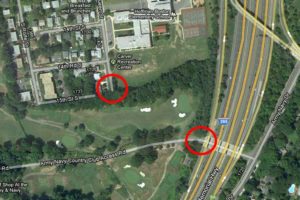 The planned access road on the grounds of Army Navy Country Club is moving forward, but not until 2020.
The planned access road on the grounds of Army Navy Country Club is moving forward, but not until 2020.
The project was approved by the Arlington County Board in the 2015-2024 Capital Improvement Program. It will include a sidewalk and provide cyclists and pedestrians access from the Columbia Pike area to Pentagon City, according to county Bicycle and Pedestrian Programs Manager David Goodman.
“It was originally envisioned as a trail, but ultimately it has more value as an emergency access drive that also allows pedestrian and bicycle activity,” Goodman told ARLnow.com. “Its purpose is to provide an escape valve for getting emergency vehicles between the two sides of I-395. There really aren’t any other connections there.”
The CIP calls for the project to begin the planning phase in FY 2020, and for construction to occur in FY 2022 and 2023. The total project cost is estimated at $5.2 million, and the CIP calls for it to be paid for with state transportation funds. Goodman, who is leading the project, said the $5.2 million is a “back-of-napkin” estimate because there has been no preliminary engineering work done, but it’s possible it will cost less.
The approval in the CIP is the first concrete step toward building the path since the county received the easement for a 30-foot-wide stretch of property along the golf course in 2010. The easement was granted in exchange for zoning approval for a new clubhouse. At the time, members of the country club filed a lawsuit against the club’s leadership trying to block the path from being built.
The road will require a retaining wall because it will be at “a very steep grade,” Goodman said. It will likely have safety bollards on the entrances to block civilian motorist traffic from entering, but allowing the flow of cyclists and pedestrians.
“It’s a very steep and narrow piece of land we were given,” he said. “It’s just a leftover piece of land they were never going to use… Retaining walls are always expensive. We were asked to work with the easement we were given.”

